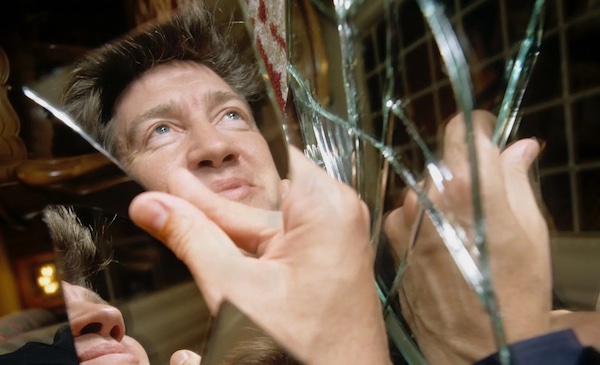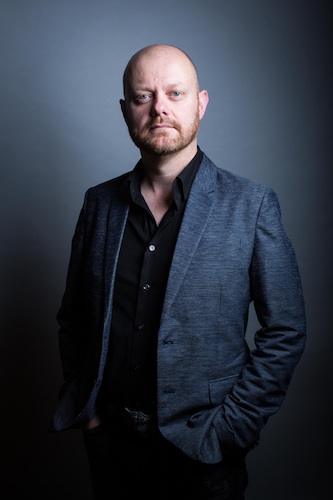Film Review: “Lynch/Oz” — Nobody’s in Kansas Anymore
By Peter Keough
Lynch/Oz roams from The Yellow Brick Road to Mulholland Drive.

A scene from Lynch/Oz.
Though the title might not allude to Roland Barthes’s S/Z, a 1973 deconstruction of the Honoré de Balzac story “Sarrasine,” Alexandre O. Philippe’s chatty, split-screen- and clip-heavy Lynch/Oz (2023; at the Brattle Theatre July 7-10) partakes of the late post-structuralist’s disruptive spirit. But it lacks that work’s rigor and focus, not to mention that of Philippe’s own Memory: The Origins of Alien (2019). It wanders afield from its titular topic — the intertextuality of David Lynch’s oeuvre and the Wizard of Oz (1939) — to digressions of varying relevance and interest. Which is what you might expect when asking for input from six filmmakers and one film critic.
The latter, Amy Nicholson of the Unspooled podcast, opens the proceedings with a fascinating if wayward insight into the parallels between Oz and Frank Capra’s It’s a Wonderful Life (1946). Unfortunately, the film is not by the perversely Capra-esque Lynch (though, for Barthes, authors do not really exist, let alone auteurs). But if it had been it would probably have provided a more entertaining immersion into the debased, Twin Peaks-like, non-George Bailey Bedford Falls of Pottersville.
Nonetheless, as Nicholson observes, both films were “flops” when they opened (a bit harsh for Oz, not so for Life, which more or less ended Capra’s career). Both were given a second life when they were rereleased in theaters and on TV as annual events celebrating the holidays. In Oz, Dorothy longs to escape the monochrome of Kansas for somewhere over the rainbow; in Life George vows to shake off the dust of his crummy town and see the world. And so on.
But so much for It’s a Wonderful Life. Where does Lynch fit into this? For a while, Philippe fills the screen with Oz-like clips from Star Wars (1977), O Brother Where Art Thou? (2000), and A Matter of Life and Death (1946) before Nicholson finally cuts to the chase and talks about Wild at Heart (1990), the Lynch film that most overtly and gratuitously references Oz — and not in a good way. She concludes by suggesting that Oz is Lynch’s own story — that of a naïf from the Kansas-like sticks of Missoula who gets hit on the head in some way, travels to realms of the unconscious and superconscious, and takes us along for the ride.

Documentarian Alexandre O Philippe. Photo: Bas Bogaerts
Filmmaker Rodney Ascher is an old hand at this kind of thing, doing Barthes proud in his combing over the secrets of Stanley Kubrick’s The Shining (1980) in Room 237 (2012) and plunging into the Wachowskian deep end with A Glitch in the Matrix (2021). As with Nicholson, he starts off topic, comparing Oz with the admittedly “non-Lynchian” Back to the Future (1985) and observing that Oz is “a really sturdy template” and that “you can apply it to almost anything.” But the specific links he eventually poses between Lynch and Oz are pedestrian (“Paul Atriades is a very Dorothy-like character…”).
More compellingly, Ascher evokes the chilling effect of breaking the fourth wall, describing how a film can reach out from the screen and enter your life. It is kind of like what happens to the guy and his psychiatrist in the back lot of Winkies in Mulholland Drive, or what the subconscious mind does in the malady called sleep paralysis that Ascher explores in his documentary The Nightmare (2015). For him this occurred after repeatedly watching episode 8 of Twin Peaks: The Return. The first time he watched it his cat acted strangely, rubbing itself against the screen. Overnight the animal somehow caught and bloodily murdered a bird even though the cat had been inside the house the whole time. And the second time Ascher watched it he found out his father died.
Speaking of which, I find it curious that in none of these readings does anyone refer to Freud.
Of all the commentators, John Waters, as is his wont, has the funniest jokes. He recalls that his first viewing of Oz “made me want to be in show business … to create characters like that … to go on adventures … and probably made me take LSD.” His favorite character is the Wicked Witch, and he muses that she and Divine would have gotten along well together. Waters knew Lynch back in the day and he recalls how he plugged Eraserhead (1977) when it first came out as a midnight movie, encouraging its success and Lynch’s career. Lynch is still grateful for that endorsement.
Karyn Kusama (The Invitation, Destroyer) also shares her personal encounters with Lynch. As a struggling artist she worked at a diner where Lynch was a frequent customer; he ate pancakes with lots of syrup. Later she attended a screening of Mulholland Drive where Lynch did a Q & A. In answer to the question “What does it mean?” he said, “I think you know.”
Of all the filmmakers interviewed, Kusama sticks closest to the premise of the movie, explaining the structural parallels between Oz — in which two thirds of the film is a dream; or is it the other way around? — and Lynch’s films, in which maybe everything is a dream. Perhaps because of her own Lynchian diner experience she, like Ascher, returns to that dreaded back lot of Winkies in Mulholland Drive and finds a nightmare composed of makeup, artifice, and the fatal human need to seek what is hidden regardless of the cost.
Picking up on a theme mentioned by Kusama, filmmaking team Justin Benson and Aaron Moorhead (The Endless, Synchronic) ponder the significance of the name “Judy,” which can refer both to the star of Oz and to the demonic entity possessing Sarah Palmer in Twin Peaks: The Return. But first they indulge in the obligatory litany of other, non-Lynchian films that share motifs, iconography, and themes with Oz, from Time Bandits to Apocalypse Now.
Finally, they return to Lynch, who, they note, does not simply “regurgitate” Oz but deconstructs and reassembles it. To illustrate this, they analyze Wild at Heart, perhaps the most regurgitated of Lynch’s films.
In it, they detail a neglected political aspect of Lynch where he exposes how the American ideal of conformity, prosperity, and consumption is only made possible through oppression and exploitation. “Judy,” both the broken movie star and the demonic, avenging entity, is a victim of and response to this system’s fundamental evil of patriarchal tyranny and misogyny.
David Lowery (A Ghost Story; The Green Knight), on the other hand, wonders if Oz might be a “quaalude for the proletariat” in that it teaches that Technicolor fantasies are fine for dreamers but there’s still no place like home — i.e., toiling in the dust of monochrome, Depression-blighted Kansas. An intriguing idea, but he never returns to it as he ventures deeper and deeper into the interconnection of directors, ranging from Alfred Hitchcock to Abbas Kiarostami, all somehow spun off from the Oz ur-text.
At a certain point, as Ascher had suggested in his segment, the comparisons, allusions, and parallels proliferate to pointlessness. The search for meaning and connections can result in such a multiplicity of meanings and connections that it ultimately becomes meaningless and amorphous.
Which may be the point. Perhaps Barthes put it best when he wrote:
“In this ideal text, the networks are many and interact, without anyone being able to surpass the rest; this text is a galaxy of signifiers, not a structure of signifieds; it has no beginning, it is reversible; we gain access to it by several entrances, none of which can be authoritatively declared to be the main one.”
If The Wizard of Oz is the ideal cinematic text, then David Lynch is its ideal reader.
Peter Keough writes about film and other topics and has contributed to numerous publications. He had been the film editor of the Boston Phoenix from 1989 to its demise in 2013 and has edited three books on film, most recently For Kids of All Ages: The National Society of Film Critics on Children’s Movies (Rowman & Littlefield, 2019).
